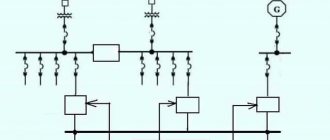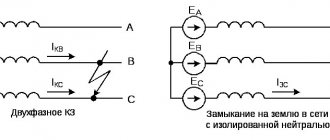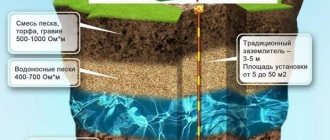Good afternoon
Tell me what is the technology for producing cable couplings. The fact is that recently, while making a hole in the ground for a support, I came across some kind of cable, apparently a connection, and, naturally, accidentally damaged it.I examined the damage - the wires seem to be intact, but the insulation is damaged. I heard that a good fine could be imposed for this, so I didn’t call anywhere. In general, there is an urgent need to patch up the gap and hide traces of activity while “the wind blows without stones.”
Work to restore cable integrity
Reply to reader
Welcome, stranger. Yes, it’s not for nothing that they say that it is impossible to change the people! The electricians of our site, over the years of their work, have more than once encountered homemade couplings, and they have never been seen before. If you think about it, you can organize a full-fledged exhibition.
All this, of course, is lyrics, so let’s talk about serious things step by step.
Type of damaged cable
First of all, you need to understand which cable you are dealing with. There are several options:
- A high-voltage power cable is a less likely option, since the voltage inside such a conductor exceeds 6 kV. The diameter of such cables ranges from 40 to 70 mm, and the cores inside them will be as thick as a finger, covered with a thick layer of insulation. It is not easy to break such a cable, but if this happens, then you would not be able to help but notice the impact, akin to a decent explosion.
- Power low-voltage electrical cable - the word low-voltage can be a little confusing, since the fact that in the concept of electricians low voltage means 220 or 380 Volts, which can be enough to cause death. The diameter of such cables is quite different and can be either 20 or 80 millimeters.
Danger! You will not be able to repair the power cable yourself, except perhaps a low-voltage one. And then you need to be sure that there is no voltage and it will not appear during installation of the coupling!
- Communication cables are low current . Their diameter can be from 5 to 60 mm. It is worth knowing that cables whose thickness is more than 40 mm are not laid directly into the ground, but are pulled through the telephone sewer. The peculiarity of such cables is that the number of cores in it can reach several hundred, which actually means that self-repair is impossible.
- Fiber optic lines are a separate group . Their peculiarity is that they have very strong armor, so causing damage to them is quite problematic. The diameter of such cables is 10-20 mm. You can’t even dream of repairing such lines yourself.
You can distinguish power and communication cables by their appearance. In the case of the former, polyvinyl chloride or paper is used for insulation, and the cores themselves are made of aluminum, although there are exceptions.
Others are characterized by polyethylene insulation and copper conductors. We won’t describe how to distinguish insulation materials, but you can watch the video or search for information on the Internet.
Sealing the cable end
Using a knife, 20 mm of the outer sheath of the heating cable is removed. The shell is easy to cut, so you should not use much effort when making cuts.
Using a sharp object, the protective braiding is unraveled. It must be removed, leaving 5 mm at the edge of the outer shell. To carefully remove the braid, you can gather it into a bundle, twist it and cut off the excess part with side cutters.
It is necessary to make a “step” at the edge of the cable using side cutters, thereby providing additional protection against short circuits between the current-carrying conductors. Next, you need to cover the resulting section with a heat-shrinkable tube DSG 12/3, taking a 40mm part.
The tube must be pushed so that the edge of the outer sheath of the cable is completely hidden on one side, and the tube extends 5 mm beyond the free edge of the cable in order to clamp the tube with pliers after heat shrinking with a hairdryer.
The tube is heat-shrinked with a hairdryer at a temperature of 200°C, starting from the middle to the edges, so as not to move the coupling. This is the first layer of heat shrink on the cable termination. After the tube tightly crimps the cable, it is necessary to make a pinch at its end, sealing the tube. In this case, glue should appear on both edges of the tube.
Next, a piece of DSG 12/3 tube, part 60mm, is put on the resulting sealed connection. The tube is pushed in such a way as to cover the edges of the first layer of insulation. There should also be about 10mm of free edge of the tube left to clamp it with pliers after heating.
The tube should tightly press the edge of the cable with the first layer of insulation. After the tube is heat-shrinkable, the free edge is hot clamped with pliers. So that the glue comes out at the end of the coupling.
This creates a completely sealed section with installation wire and termination, ready for installation.
If the section will be connected to the power supply through a socket, it is necessary to install a plug at the end of the supply wire. We recommend connecting sections no longer than 20m to the network in this way. In other cases, the section is connected through an RCD or a differential circuit breaker.
Checked by: Evgeniy Shchipunov
Chief Engineer of SKO Alfa Project LLC
Let's start repairing the line
Let’s say right away that depending on the type of cable and the nature of the damage it received, various repair methods can be used: installation of cable end joints, installation of internal cable joints (connectors). The solutions differ in the structure, size and operating voltage of the line.
Interesting to know! Sometimes a casing for the cable coupling is additionally installed in order not only to protect the connection from mechanical damage, but also to protect against fires and explosions when it comes to high-voltage lines.
Let's look at the most common options that you can use for DIY repairs.
Repairing scratches and cuts
Most often, the cable is not completely cut when damaged, but its external and possibly internal insulation suffers. To carry out such repairs you will need: mastic for cable couplings (bitumen), 3-5 centimeter polyethylene tape (you can cut a regular packaging tight bag), rags, a gas blowtorch (can be heated over a fire, but it takes a long time).
We perform the following actions:
- Heat the mastic thoroughly in an iron container until liquid.
Attention! Do not use white spirit at the same time as heating, as its vapors are very flammable. Better wait a little.
- The dimensions of the cable sleeve will be 15-20 centimeters on both sides of the cut, so release the required length of cable from the ground and clean it well and wipe it dry with rags.
- Next, using a wooden stick, mastic is applied to the desired part of the cable.
- Until the mass hardens, it is tightly covered with pre-prepared polyethylene tape.
- The squeezed out mastic is smoothed out.
- Additionally, the top of the polyethylene can be coated with a layer of bitumen.
The cost of such repairs is minimal, since all materials can be dug up in any garage.
Such repair work using factory products can be performed by:
- Welding using a special tape made of polyethylene or fiberglass.
- Heat shrinks – XAGA couplings, used in whole or in part.
Installation of cable joints
In cable routes, the joints are the most vulnerable point, so the requirements for them are no lower than for the cable itself. The connection of the cores is carried out using welding, soldering, crimping or bolting. Cable joints are used to restore the screen, insulation and armor. In addition to the actual insulation and protection of the spliced route section, installing cable sleeves allows you to solve two problems that arise when splicing cables. When connecting the cable, a section of the screen is removed. If it is not restored, the electrical characteristics of the route are disrupted. The unevenness of the electric field strength causes concentration and localization of power lines, and the resulting ionization leads to breakdown and failure of the entire cable line. The second problem is the occurrence of tracking phenomena at the joints. Pollution of the atmosphere and industrial premises leads to the deposition of dirt on the insulation and the formation of conductive paths. The consequences are the same - breakdown of the connection point and failure of the line. According to their purpose, cable couplings are divided into: • connecting couplings (used to connect pieces of the cable route); • branch lines (for connecting the cable line to the main line); • end (for connecting electrical installations). Mast end couplings are required for connection to overhead power lines. Cable sleeves are: • lead, • made of epoxy mixtures, • heat-shrinkable • cold-shrinkable. The sleeve must provide resistance to the environment, mechanical and electrical strength, be sealed and moisture-resistant. These requirements are best met by hot and cold shrink couplings used to connect cables with any insulation. Their use allows you to reduce labor and time costs and carry out work in tight spaces. These seemingly similar couplings differ in physical properties, installation methods and applications. Heat-shrinkable sleeves can be used for any method of laying cable lines, they have a long service life - more than 30 years, and are easy to install. One standard size of heat-shrink sleeve can be used for different sections of cores and types of cables; their fittings are practically not subject to aging and can be stored indefinitely. Heat-shrinkable sleeves have high rigidity and are resistant to most aggressive environments, but require UV protection. Cold shrink couplings have all the advantages of heat-shrinkable couplings, but do not require heating during installation; this reduces the installation time of the coupling by approximately 2 times. During cold shrinkage, silicone or EPDM rubber is used as an insulating material. Silicone is UV resistant and repels water, but is not very abrasion resistant. EPDM rubber cable sleeves are more durable, but require additional protective measures against UV radiation. At the point of connection with thermo- and cold-shrinkable couplings, the flexibility of the cable is maintained, they are resistant to cyclic temperature changes and seasonal soil movements, their tensile strength is 60% of the tensile strength of the cable itself. When carrying out work on cable lines, it is optimal to combine both technologies. Installation of heat-shrinkable cable sleeve
Before installing the coupling, the end of the cable is cut: sequentially, with some shift, all its layers are removed, starting from the outer protective coating to the phase insulation of each core.
The cutting dimensions are strictly regulated, depend on the cross-section and brand of cable cores, line voltage, and are given in reference books and installation instructions. The heat shrink sleeve kit includes: tubes, cuffs, hoses, gloves and other elements supplied in an extended state. During installation, they are easily put on the elements of the cut cable. Heating with a construction hairdryer or torch causes the parts to shrink; they tightly envelop the cable elements and provide mechanical strength to the structure. The shrinkage temperature is 120-150°C, it is not dangerous for insulation. When heated, sealants applied to the internal surfaces of the coupling parts melt, fill the voids and seal the joint. Sealants contain special additives that level the electric field at the point of contact. This protects the connection from breakdown. The installation diagram for the heat-shrinkable end sleeve of a single-core cable is shown in the figure: a - stripped cable; b - shrinkage of the tube that equalizes the electric field; c - shrinkage of the vein cuff; g - connecting the grounding conductor and shrinking the hose; d - shrinkage of the end collar; e - shrinkage of the waist cuff. Installation of a three-core cable is carried out in the same way, but instead of heat-shrinkable tubes, heat-shrinkable gloves are used. They are put on the 3-phase cores of a pre-cut cable. Installation of a cold-shrinkable cable sleeve
A cold-shrinkable sleeve is a pre-stretched product placed on a spiral-shaped plastic cord. As the spiral is removed, the sleeve fits tightly around the cable, providing a complete seal. The thick walls of the coupling reliably protect against mechanical influences. The figure shows a cold-shrinkable coupling for a single-core cable: 1 - housing; 2 - plate with a layer of semiconductor material; 3 – protective casing; 4 – mastic, leveling the electric field; 5 - sealant; 6 — screen; 7 - connecting sleeve. The installation diagram of such a coupling is shown in the figure: a - preparation of screens; b - connection of cores; c — overlay at the junction of the plate leveling the electric field; d - putting the coupling on the junction of the cores; d - removal of the spiral cord; e - the connection is ready to apply voltage.
Types of end couplings
Heat-shrinkable end couplings (MKT) come in two types:
- MKT internal installation;
- MKT outdoor installation.
MKT indoor installation
Internal installation of MKT involves installation of a cable connection unit indoors. That is, the cable termination provides a reliable connection where there are no environmental factors. The product cannot be used outside buildings and structures.
MKT outdoor mounting
Installation of MKT for external use is mainly carried out when connecting power cables to distribution cabinets and other objects for similar purposes. Installation of external couplings is carried out in those places where the contact group is exposed to the risk of negative effects of the surrounding space (precipitation, low or high temperature conditions, etc.).
Important! The presence of the letter “B” in the MKT marking means that the product is suitable only for internal use. The letter “N” refers to the product as a type of coupling for external use
3.3. Sealing of couplings at the junction of cables in dissimilar sheaths TPPepZ, TPppZP and TG
3.3.1. According to section 11 of the “Guidelines for the construction of linear structures of local communication networks” (M. SSKTB. 1995), splicing of cables with a polyethylene sheath of the TP type and with a lead sheath of the TG type is carried out using a lead coupling and a lead bushing.
After soldering the lead coupling to the bushing, LG-2 tape is wound onto the bushing, up to half of it, onto the cable sheath for a length of 50-60 mm with 50% overlap. Three layers of PVC tape are wound on top of the LG-2 tape with 50% overlap (Fig. 3.29).
Rice. 3.29. Winding of the junction of the lead bushing with the polyethylene sheath of the cable.
On top of the PVC tape, close to the lead bushing, apply two layers of “Armoplast” with a 50% overlap. Winding starts from the lead coupling and returns to it. On the cable sheath, the tape should overlap the PVC tape. Figure 3.30 shows the application of Armoplast tape at the junction of the lead bushing with the polyethylene sheath of the cable.
Rice. 3.30. Applying Armoplast tape to the joint of the lead bushing with the polyethylene sheath of the cable.
3.3.2. At the junction of cables such as TP and TPV; TG and TPV
Currently, this option is found, as a rule, when installing branch couplings in ATS shafts (station couplings). In this case, sealing is carried out only with LG-2 and PVC tapes. Armoplast tape is not used
The difference between couplings
Couplings are a set of parts and materials designed to restore the electrical, structural and mechanical integrity of the cable.
| End couplings up to 1 kV | Connecting couplings up to 1 kV |
| 3; 4 ; 5 PKV(N)Tp-1 3 ; 4 ; 5 PKV(N)Tp(b)-1 3 ; 4 KV(N)Tp-1 | 3; 4 ; 5 PST-1 3; 4 ; 5 PST(b)-1 3 ; 4 STp-1 |
| End couplings up to 10 kV | Connecting couplings up to 10 kV |
| 3 KVTp-10 3 KNTp-10 1 PKVT-10 1 PKNT-10 | 3 STp-10 1 PST-10 |
*1. Universal coupling for a 4-core cable up to 1 kV 2. It is recommended if it is impossible to know in advance the type of core insulation for 4-core cables, the cost of such a coupling is higher than for a cable with plastic insulation 3. The couplings have a universal kit for connecting the grounding conductor: For soldering - a set of solders and soldering fat. For unsoldered - a spring, a grater.
Expert opinion
It-Technology, Electrical power and electronics specialist
Ask questions to the “Specialist for modernization of energy generation systems”
Connecting and end heat-shrinkable sleeves for cables - Construction technologies adjust the burner so that the flame is soft with tongues of a characteristic yellow color; it is not allowed to mount the sleeve with a burner flame of blue color or in the shape of a sharp wedge;. Ask, I'm in touch!
TYPES
1.1. The types of couplings and their scope of application must correspond to those indicated in Table 1.
What kind of lighting do you prefer?
Built-in Chandelier
For connecting distribution cable lines to the main cable line
For connecting cables with plastic insulation to cables with impregnated paper insulation and cables with paper insulation impregnated with a non-drip compound
For connecting cables with impregnated paper insulation, laid on routes with a difference in levels exceeding those specified in the regulatory and technical documentation for cables
For connecting multi-core cables with impregnated paper insulation with single-core cables with paper insulation impregnated with a non-drip compound or with single-core cables with plastic insulation
For terminating cables outdoors when transitioning from a cable line to an overhead power line
1.2. Couplings of types C, ST, STP and SP must have protective covers, except for couplings with a cast iron body. When laying them in the ground, it is allowed to use couplings made of casting resins without protective covers.
The types and scope of application of protective covers must correspond to those indicated in Table 2.
For couplings installed in channels, tunnels and other premises
An example of a designation for a coupling based on self-adhesive tapes and heat-shrinkable tubes, designation 8, with a protective underground plastic casing with an internal neck diameter of 75 mm, for a three-core cable with plastic insulation with a core cross-section of 3x120 mm, for a voltage of 6 kV:
An example of a symbol for a lead coupling with a neck diameter of 100 mm in a protective underground cast iron casing with an internal neck diameter of 75 mm for a three-core cable with paper insulation, core cross-section 150 mm, for a voltage of 10 kV:
An example of a symbol for a connecting brass single-phase coupling with a protective cast-iron casing for underwater installation with rings for fastening the armor of a paper-insulated cable with a conductor cross-section of 3x120 mm, for a voltage of 35 kV:










